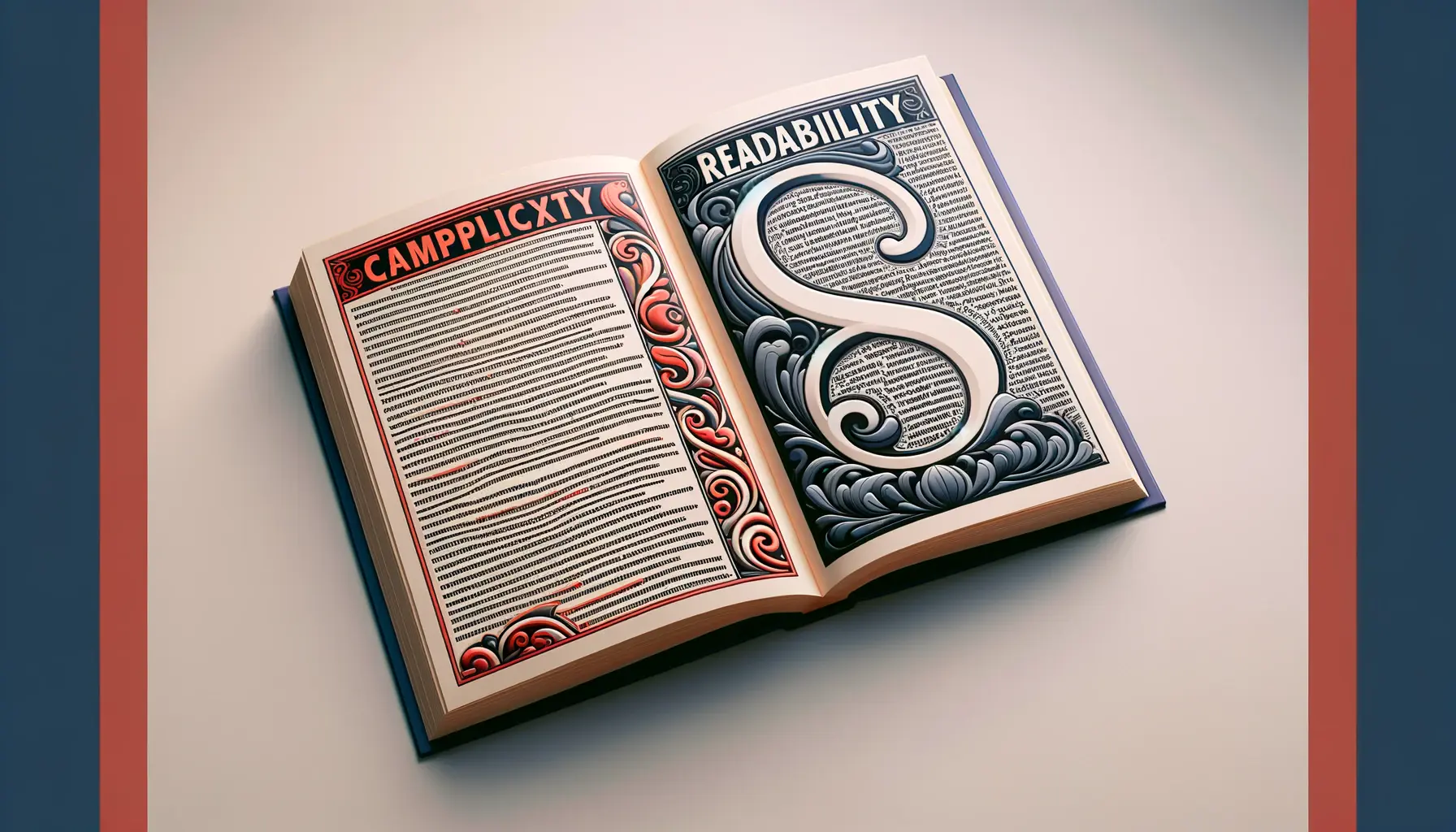The evolution of digital typography has been a journey of not just aesthetic appeal but also of enhancing readability and user experience.
As we step into 2024, the focus on sans-serif fonts has intensified, driven by their clean lines and modern appearance.
Sans-serif, a term that literally means “without serifs,” refers to fonts that lack the small projecting features called “serifs” at the end of strokes.
This simplicity is not just a matter of style but is deeply rooted in the principles of readability and accessibility in digital design.
Understanding the significance of sans-serif fonts requires a dive into the nuances of typography and its impact on reading online content.
The choice of font type can significantly affect how readers perceive and interact with text, making typography a crucial element in content strategy.
Sans-serif fonts, with their straightforward and unadorned style, offer clarity and legibility that is paramount in digital environments, where distractions are plentiful and attention spans are short.
- The Rise of Sans-serif in Digital Typography
- Understanding Readability and Accessibility
- Optimizing Typography for Mobile Devices
- The Psychological Effects of Font Choice
- Global Trends in Typography and Sans-serif
- Designing for Readability: Tips and Techniques
- Future Directions in Typography and Sans-serif
- Embracing Sans-serif for the Future of Digital Readability
- Sans-serif Fonts and Readability FAQs
The Rise of Sans-serif in Digital Typography
Historical Context and Digital Adoption
The adoption of sans-serif fonts in digital platforms did not happen overnight.
It was the result of a gradual shift that mirrored the evolution of digital screens and user interfaces.
Initially designed for their simplicity and readability in print, sans-serif fonts like Arial, Helvetica, and Verdana quickly found their way into digital design due to their clear and legible appearance on low-resolution screens.
This historical context sets the stage for understanding why sans-serif fonts are preferred in digital content today.
As screen resolutions improved and digital content became more dynamic, the versatility of sans-serif fonts allowed them to adapt seamlessly.
Their straightforward design meant that they could be easily scaled for different devices, maintaining readability across smartphones, tablets, and desktops.
This adaptability is a testament to the enduring relevance of sans-serif fonts in the digital age.
Psychological Impact on Readers
The psychological impact of sans-serif fonts on readability and user experience cannot be overstated.
Studies have shown that the simplicity of sans-serif fonts contributes to easier word recognition and faster reading speeds, especially in digital contexts.
This is because the absence of serifs makes each letter more distinguishable, reducing the effort required for the brain to process text.
Moreover, the clean and modern aesthetic of sans-serif fonts aligns with contemporary design trends, influencing how users perceive the credibility and professionalism of a website or application.
This psychological effect extends beyond mere readability, affecting user engagement and the overall success of digital content.
Sans-serif fonts enhance readability and user experience by offering clear, legible text that aligns with modern design trends.
Understanding Readability and Accessibility
At the heart of typography’s role in digital design lies the concept of readability and accessibility.
These two factors are crucial in determining how effectively a user can consume and understand digital content.
Readability refers to how easily words, phrases, and blocks of text can be read, while accessibility concerns the design’s inclusivity, ensuring content is decipherable by people with varying degrees of visual impairment.
Readability is influenced by several factors, including font size, line height, and letter spacing.
Sans-serif fonts, with their straightforward design, naturally enhance readability by creating a cleaner and more open text layout.
This simplicity becomes even more critical when considering accessibility standards, which aim to make digital content usable for everyone.
Key Components of Readable Design
- Font Size: Larger font sizes improve legibility, making text easier to read for users with visual impairments.
- Line Height: Adequate spacing between lines of text prevents crowding, enhancing the overall readability.
- Letter Spacing: Increasing the space between letters can help in distinguishing individual characters, reducing reading effort.
- Color Contrast: High contrast between text and background colors is essential for users with low vision.
Accessibility in typography goes beyond these elements, incorporating the choice of font type as a pivotal decision.
Sans-serif fonts are often recommended for digital texts due to their legibility and simplicity, which align with the principles of accessible design.
Impact on User Experience
The cumulative effect of readability and accessibility enhancements is a significant improvement in user experience (UX).
A design that considers these elements not only caters to a wider audience but also fosters an environment where information is easily consumable.
This inclusivity in design is not just a matter of ethical responsibility but also a strategic approach to increase engagement and reduce bounce rates on digital platforms.
By prioritizing sans-serif fonts in digital content, designers and content creators can ensure that their message is not only seen but also understood by the broadest possible audience.
This approach to typography is a cornerstone of modern web design, reflecting a shift towards more user-centric digital experiences.
Choosing the right sans-serif font can significantly impact the readability and accessibility of your digital content, enhancing user engagement.
Optimizing Typography for Mobile Devices
In the era of smartphones and tablets, optimizing typography for mobile devices has become a critical aspect of web design.
The challenge lies in maintaining text legibility and readability across a wide range of screen sizes and resolutions.
Sans-serif fonts play a pivotal role in this context, offering clarity and simplicity that are essential for mobile readability.
Mobile optimization involves more than just choosing the right font; it requires a comprehensive approach that considers various aspects of mobile UX design.
The goal is to ensure that content is not only accessible but also engaging for mobile users, who now constitute a significant portion of web traffic.
Best Practices for Mobile Typography
- Responsive Font Sizes: Utilizing responsive design techniques to adjust font sizes based on screen size ensures text remains legible on any device.
- Minimalist Design: A clean, uncluttered layout with ample white space enhances readability, making sans-serif fonts an ideal choice for mobile interfaces.
- Touch-friendly Interfaces: Designing for touch interactions requires larger tap targets, which in turn necessitates careful consideration of text placement and size.
- Screen Orientation: Ensuring text is readable in both portrait and landscape modes is crucial for a seamless mobile experience.
The implementation of these practices highlights the versatility of sans-serif fonts in adapting to the constraints and opportunities of mobile design.
Their straightforward shapes and absence of decorative elements make them highly readable, even on small screens.
Case Study: Mobile App Typography
Consider a mobile app that underwent a redesign to improve user engagement.
The developers switched to a sans-serif font, focusing on optimizing text for readability.
They adjusted font sizes and line heights for different screen sizes and orientations, resulting in a significant increase in user session times and a decrease in bounce rates.
This case study underscores the impact of thoughtful typography choices on mobile user experience.
The strategic use of sans-serif fonts in mobile contexts not only addresses the technical challenges of readability on small screens but also aligns with contemporary aesthetic preferences.
As mobile devices continue to dominate internet usage, the importance of optimizing typography for these platforms cannot be overstated.
Incorporating sans-serif fonts in mobile design is not just a trend but a necessity for creating accessible, engaging digital experiences.
The Psychological Effects of Font Choice
The choice of font in digital content does more than just affect readability; it also has profound psychological effects on the reader.
Sans-serif fonts, in particular, are associated with a modern, clean aesthetic that can influence the perception and mood of the audience.
Understanding these psychological implications is crucial for designers and content creators aiming to convey a specific message or evoke certain emotions through their digital platforms.
Typography can subtly signal the tone of the content, whether it’s professional, casual, friendly, or authoritative.
The simplicity and clarity of sans-serif fonts often communicate a sense of straightforwardness and efficiency, making them a popular choice for brands looking to establish trust and reliability.
Conveying Brand Personality
- Modern and Minimalistic: Sans-serif fonts are often used by brands that want to project a modern, innovative image. Their clean lines suggest efficiency and forward-thinking.
- Approachable and Friendly: The absence of serifs can make text appear more approachable, ideal for brands aiming for a friendly and inclusive vibe.
- Professional and Trustworthy: The clarity and legibility of sans-serif fonts convey professionalism, making them suitable for businesses that prioritize trust and reliability.
These associations are not arbitrary but are rooted in the cultural and historical context of font development and usage.
As digital design evolves, so do the connotations attached to different font types, with sans-serif fonts increasingly symbolizing contemporary values and sensibilities.
Impact on User Engagement
The psychological impact of font choice extends to user engagement.
Fonts that align with the brand’s personality and content’s tone can significantly enhance the user’s connection to the material.
For instance, a website that uses a sans-serif font to present long-form articles can facilitate a smoother reading experience, encouraging users to spend more time on the site and engage more deeply with the content.
Moreover, the emotional response elicited by a font can influence the user’s perception of the content’s quality and relevance.
A well-chosen sans-serif font can make the content appear more accessible and digestible, leading to higher satisfaction levels and a better overall user experience.
The psychological effects of sans-serif fonts on digital content can significantly influence user perception and engagement, underscoring the importance of thoughtful typography choices.
Global Trends in Typography and Sans-serif
The landscape of digital typography is continually evolving, influenced by technological advancements, cultural shifts, and user preferences.
Sans-serif fonts, with their clean and minimalist aesthetic, have emerged as a dominant force in this evolution, reflecting broader trends in design and communication.
As we navigate through 2024, it’s essential to understand the global trends that are shaping the use of sans-serif fonts in digital content.
One of the key drivers of these trends is the increasing emphasis on digital accessibility and inclusive design.
With the internet becoming more integral to daily life, ensuring content is accessible to all users has become a priority for designers and content creators.
This focus on accessibility has bolstered the popularity of sans-serif fonts, known for their readability and simplicity.
Adoption in Branding and UI Design
- Branding: Many global brands have adopted sans-serif fonts for their logos and branding materials, seeking a modern and accessible image that resonates with a wide audience.
- User Interface Design: In UI design, sans-serif fonts are favored for their clarity and ease of reading on various devices, from desktop monitors to mobile screens.
This widespread adoption is not just a matter of trend-following but a strategic choice that aligns with the values of modern digital culture.
Sans-serif fonts offer a blend of aesthetic appeal and functional benefits, making them a go-to choice for contemporary design projects.
Impact of Social Media and Content Platforms
Social media and content platforms have also played a significant role in popularizing sans-serif fonts.
These platforms prioritize user engagement and content readability, making sans-serif fonts an ideal choice for their interfaces and content.
The uniformity and simplicity of sans-serif fonts facilitate a seamless experience across different content types and formats, from text posts and comments to multimedia presentations.
The influence of these platforms extends beyond their own interfaces, setting design standards that affect broader web and app design practices.
As a result, sans-serif fonts have become synonymous with the modern, digital-first approach to typography, embodying the principles of clarity, efficiency, and inclusivity that define the digital age.
The global trends in typography underscore the growing importance of sans-serif fonts in creating accessible, engaging, and modern digital content.
Designing for Readability: Tips and Techniques
Creating content that is both visually appealing and easy to read requires a careful balance of design elements.
Sans-serif fonts, with their clean lines and unadorned forms, provide a solid foundation for readability.
However, maximizing the potential of these fonts involves more than just selecting the right typeface.
It requires a comprehensive approach to design that considers how text interacts with other elements on the page.
Here, we delve into practical tips and techniques for enhancing readability using sans-serif fonts.
These strategies are designed to optimize the user’s reading experience, ensuring that content is not only accessible but also engaging.
Contrast and Color
- High Contrast: Ensure there is sufficient contrast between the text and the background. High contrast makes the text stand out, improving legibility.
- Color Choices: Select colors that complement each other while maintaining high contrast. Avoid colors that clash or are too similar in tone to the background.
Contrast and color play a crucial role in readability.
They can either make text easy to read or strain the eyes.
By choosing the right colors and ensuring high contrast, designers can significantly enhance the legibility of sans-serif fonts.
Spacing and Alignment
- Line Spacing: Adequate line spacing, or leading, allows the eye to easily move from one line to the next. A general rule is to set line spacing at 1.5 times the font size.
- Paragraph Alignment: Justified text can create uneven spacing between words, making it harder to read. Aligning text to the left (for languages that read left to right) is often more readable.
Proper spacing and alignment are essential for creating a comfortable reading experience.
They help organize the text in a way that feels natural to the eye, reducing fatigue and making it easier for readers to absorb the content.
Utilizing White Space
White space, or negative space, refers to the unmarked areas of a design.
It’s not merely empty space but a powerful design element that helps to break up text and separate different sections.
Effective use of white space around text blocks and between paragraphs can make content more digestible, guiding the reader’s eye through the page and improving overall readability.
By implementing these design principles, content creators can leverage the strengths of sans-serif fonts to produce digital content that stands out for its clarity and ease of reading.
These tips and techniques are fundamental to creating a user-friendly digital environment that prioritizes the reader’s experience.
Effective use of sans-serif fonts, combined with thoughtful design choices, can significantly enhance the readability and appeal of digital content.
Future Directions in Typography and Sans-serif
The dynamic nature of digital design means that typography, including the use of sans-serif fonts, is always evolving.
As we look towards the future, several trends and technological advancements are set to shape the way we use fonts in digital content.
Understanding these potential directions can help designers and content creators stay ahead of the curve, ensuring their work remains relevant and impactful.
One of the key areas of development is the integration of typography with emerging technologies such as augmented reality (AR) and virtual reality (VR).
These platforms present new challenges and opportunities for typography, where readability and user experience take on new dimensions.
Typography in AR and VR
- Readability in 3D Spaces: Sans-serif fonts, with their clarity and simplicity, are well-suited for use in 3D environments, where legibility can be affected by depth and perspective.
- Adaptive Typography: Future developments may include fonts that dynamically adjust to the user’s viewing angle and distance, enhancing readability in immersive experiences.
The potential for typography to adapt to the user’s environment in AR and VR could revolutionize how we think about text in digital spaces.
Sans-serif fonts are likely to play a significant role in this evolution, given their versatility and legibility.
AI and Machine Learning in Typography
Another exciting development is the application of AI and machine learning to typography.
These technologies could enable the creation of smart fonts that optimize readability based on user preferences, context, or even specific visual impairments.
Sans-serif fonts could be at the forefront of this innovation, offering a base for algorithms to build upon and customize text presentation in real-time.
This future-oriented approach to typography, where design elements are not static but responsive to the user’s needs, represents a significant shift in how we think about and interact with digital content.
As sans-serif fonts continue to evolve, they will likely remain central to these advancements, offering a blend of aesthetic appeal and functional utility that meets the demands of future digital landscapes.
Exploring the future of typography reveals the enduring relevance of sans-serif fonts, poised to adapt and thrive in the face of technological advancements and changing user expectations.
Embracing Sans-serif for the Future of Digital Readability
As we have explored throughout this article, sans-serif fonts are not just a stylistic choice but a cornerstone of modern digital design, deeply intertwined with the principles of readability, accessibility, and user experience.
The evolution of digital typography, particularly the rise of sans-serif fonts, reflects a broader shift towards designs that prioritize clarity, efficiency, and inclusivity.
These fonts have proven to be incredibly versatile, adapting to various contexts from mobile screens to immersive AR and VR environments.
The Enduring Appeal of Sans-serif
The clean and minimalist aesthetic of sans-serif fonts has a timeless appeal that transcends current trends.
Their simplicity is their strength, offering legibility and clarity that enhance the user’s reading experience.
As digital content continues to evolve, the importance of these fonts only grows, highlighting their role in creating accessible and engaging digital environments.
Future Trends and Technological Advancements
Looking ahead, the integration of sans-serif fonts with emerging technologies like AI, AR, and VR presents exciting possibilities for typography.
These advancements promise to make digital content more dynamic, responsive, and personalized, further enhancing the user experience.
Sans-serif fonts, with their inherent readability and simplicity, are ideally positioned to benefit from these developments, ensuring their continued relevance in the digital landscape.
Key Takeaways for Designers and Content Creators
- Sans-serif fonts are essential for maximizing readability and accessibility in digital content.
- The choice of sans-serif fonts can significantly impact user engagement and perception, underscoring the need for thoughtful typography choices.
- Emerging technologies offer new opportunities for enhancing typography, with sans-serif fonts playing a central role in these advancements.
In conclusion, the journey of sans-serif fonts from a functional choice to a symbol of modern digital design underscores their importance in creating readable, accessible, and engaging content.
As we look to the future, the potential for these fonts to adapt and thrive in new technological contexts is clear.
For designers and content creators, embracing sans-serif fonts means not only keeping pace with current trends but also preparing for the exciting possibilities that lie ahead in the evolution of digital typography.
Quality web design is key for a great website! Check out our service page to partner with an expert web design agency.
Sans-serif Fonts and Readability FAQs
Explore common questions about maximizing readability with sans-serif fonts, offering insights into their use in digital design.
Sans-serif fonts are deemed more readable due to their clean, straightforward design, which enhances legibility, especially on digital screens.
The ideal size for sans-serif fonts is at least 16 pixels, ensuring text is legible across various devices and screen resolutions.
Line height affects readability by preventing text crowding, with 130% to 150% of the font size recommended for optimal legibility.
Yes, sans-serif fonts are often recommended for people with dyslexia due to their simplicity and clear distinction between letters.
Using sans-serif fonts can significantly improve website accessibility by making content easier to read for a wider audience, including those with visual impairments.
There’s no one-size-fits-all answer, but popular choices include Arial, Helvetica, and Verdana for their widespread readability and clean appearance.
Sans-serif fonts enhance mobile readability by offering clear, legible text that adapts well to smaller screens and varying resolutions.
Sans-serif fonts play a crucial role in user experience by ensuring text is easy to read, thus improving content engagement and accessibility.










